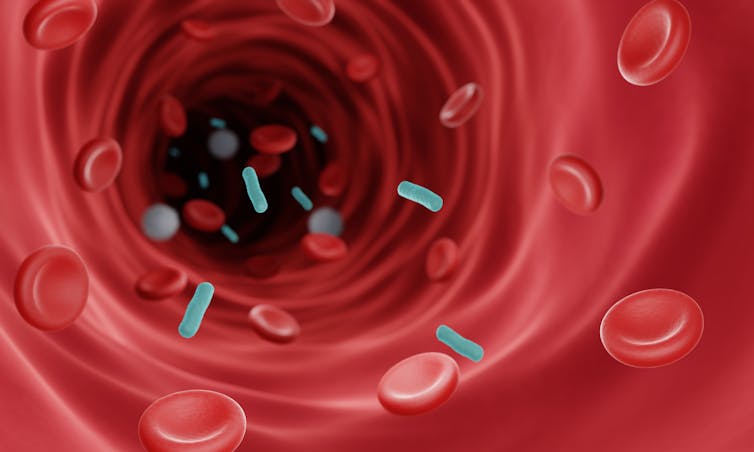Conservative MP Craig Mackinlay recently returned to the House of Commons for the first time after suffering from life-threatening sepsis last year. Since returning to public office, Mackinlay has spoken candidly about his experience with the near-fatal illness that led to the amputation of his hands and feet.
Last September, Mackinlay said he started feeling ill — but thought nothing of his symptoms, especially after testing negative for COVID.
But his condition quickly worsened during the night. When Mackinlay was finally admitted to hospital the next day, his entire body had turned blue. He was suffering from septic shock – a severe form of sepsis. Mackinlay was put into an induced coma and woke up 16 days later. He only had a 5% chance of survival.
With nearly 50 million cases and 11 million deaths each year worldwide, sepsis represents a significant global health crisis. However, despite its prevalence, sepsis remains a difficult pathology to diagnose quickly.
Sepsis is a serious illness that occurs when the body’s response to an infection damages its own tissues and organs. It can develop in a very short period of time – usually within hours, if left untreated.
Sepsis is usually triggered by a bacterial or viral infection – often in the lungs, urinary tract, abdomen or through a wound. If these pathogens escape from the infected area, they can then enter the bloodstream where they can spread throughout the body, into surrounding tissues and major organs.
Because of how quickly the infection spreads, the immune system becomes overwhelmed and becomes dysregulated, meaning it stops functioning as it normally should. This triggers an exaggerated immune response known as a cytokine storm. Not only does this cytokine storm fail to clear the infection, it also causes significant damage to tissues and organs, which can lead to serious complications or even death without prompt treatment.
Sepsis can affect anyone, although older adults, infants, young children, and people with chronic illnesses (such as diabetes, arthritis, asthma, and cancer) are at greater risk. due to differences in how their immune systems work.
Bad state
There are many reasons why sepsis is such a dangerous disease. Much depends on the difficulty of diagnosis.
The early symptoms of sepsis tend to share similarities with many other illnesses. Often, patients begin with flu-like symptoms, such as fever, rapid breathing, and rapid heart rate. These can easily be confused with other conditions or overlooked altogether.
Yet these subtle signs can become serious within hours because of how quickly sepsis progresses. It is essential that patients are treated as quickly as possible, because for every one hour delay in treatment, the risk of death increases by 8%.
Sepsis can also be triggered by a wide range of pathogens, including bacteria, viruses, fungi and parasites. It is therefore difficult to identify the exact cause of sepsis. Since each pathogen requires a different type of treatment, this means that laboratory tests must first be performed before treatment can be administered to patients.

ART-ur/Shutterstock
And, due to the complex nature of sepsis, it lacks a biological signature (or biomarker) that can be reliably used to diagnose the disease. Biomarkers play a crucial role in the diagnosis of various diseases, as they indicate the presence and severity of a disease. This means doctors must look for other signs and symptoms, alongside laboratory tests, to diagnose sepsis. But these signs do not always clearly indicate the presence of the disease – at least at first.
The future of treatment
Sepsis is treated with antibiotics or antivirals, depending on the root cause of the patient’s infection. Patients may also need fluids to maintain their blood pressure and oxygen to support the functioning of their organs, depending on their condition. In severe cases, abscesses may need to be drained, infected tissue may need to be removed, and the patient may need a ventilator or dialysis to support their breathing and organ function.
Up to 70% of people who develop sepsis survive the disease when treated promptly. Without treatment, the survival rate drops to around 20%.
About half of people who survive sepsis develop “post-sepsis syndrome” – long-term physical and emotional symptoms that can last for years. Some of these symptoms may include more frequent illnesses, feeling weak or tired, and mental health problems.
Yet some fear that current treatments for sepsis may become less effective. The overwhelming majority of cases of sepsis arise from bacterial infections. This makes antibiotics the primary route of treatment for sepsis.
But bacteria can evolve to survive exposure to antibiotics, becoming resistant to drugs commonly used to treat infections. This makes antibiotic resistance a significant contributing factor to sepsis. This resistance can make antibiotics ineffective at eradicating the initial bacterial infection, allowing it to persist and get worse.
But recent innovations in this area may offer hope. Research has discovered how pathogens stick to the walls of blood vessels – a mechanism that allows pathogens to spread throughout the body. With this discovery, trials have now begun to test whether a drug targeting blood vessels (instead of the pathogens causing the infection) can stop sepsis and reduce the need for antibiotics.
Medications that prevent pathogens from attaching to blood vessels could also be given before sepsis sets in. If proven effective, it could save millions of lives.
Efforts are also being made to introduce standardized sepsis protocols to improve early recognition of the disease in hospitals and clinics.
Sepsis can happen to anyone. The best way to avoid it is to take care of your health. It’s important to stay up to date on vaccinations, practice good hygiene, and properly care for any injuries you may have. But if any of the known symptoms of sepsis appear – including fever, chills and low blood pressure – then it is essential to seek immediate medical attention.